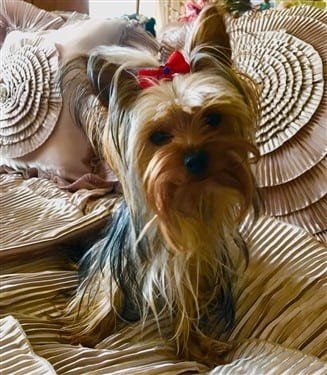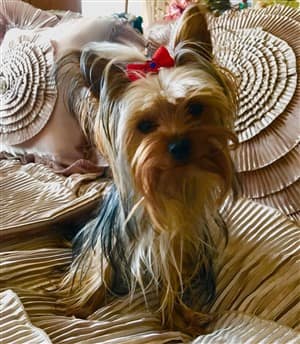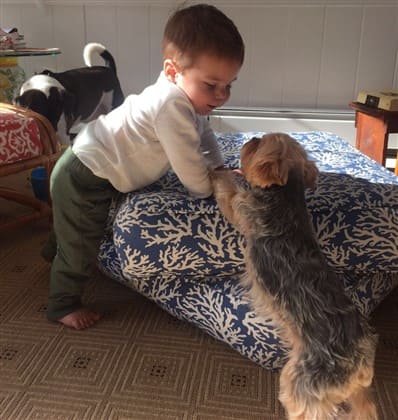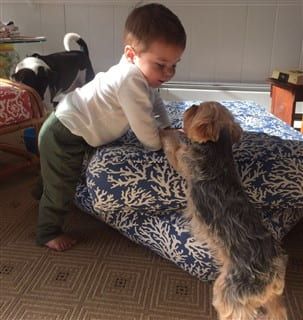When a Yorkshire Terrier Refuses to Go for Walks
Overview
You probably know all the benefits of daily exercise for a dog; so, what do you do if your Yorkie refuses to go for walks? Or maybe, things start out okay, but then your puppy or dog stops every other moment to sniff around. Following these tips in order to resolve things.
Please note:
YorkieInfoCenter is reader-supported, and some of the product suggestions on this page are affiliate links. As an Amazon Associate we earn from qualifying purchases. This is at no extra cost to you and helps us continue providing free, high-quality information.
How to Train a Yorkie to Go for Walks
# 1. Rule out physical causes.
This includes:
- Health issues that may be making your puppy or dog lethargic
- Burns or injures to the paws – Can be treated at home with a salve or may require vet treatment, depending on the extent.
- Unpleasant walking surfaces that may be causing discomfort (hot summer pavement, freezing and/or slippery winter surfaces) – Applying a quality paw wax once per week can help resolve this.
- Overheating (which can quickly lead to heat stroke).
- Overly tired – What may be a good time for you to head out, may be one that your Yorkshire Terrier is ready to take a nap. Dogs often do best in the morning and in the evening after being cooped up all day. But, adjust walking times if you suspect this as one of the causes.
Some dogs do walk, but stop often due to distractions. This will be covered, coming up.
# 2. Walks must be done with enthusiasm.
Your dog can, and does, pick up on your vibe. So, if you are feeling frustrated with how walks have gone so far, or are feeling overwhelmed with all you have on your plate, your Yorkie knows that you’re not looking forward to the walk. This will severely decrease his enthusiasm.
And, if you truly hate taking your dog for walks and find it to be the absolute worst part of your day, this especially cannot be hidden from a canine. Your Yorkie may refuse to engage in something that you’ve made clear is a horrible activity.
If either applies to you, try to think of taking walks as something beneficial for you regardless of how it goes. Make this a time that you release all worries and enjoy getting fresh air. Even if your dog were to plant himself down and not move at all, you’d still be getting fresh air, so it would not be a total loss (but, don’t worry, we’ll get your Yorkie moving!).
Lexie Little Bear, at 1 year old, photo courtesy of Helen Gorsuch
# 3. Make walks worthwhile.
A dog will agree to a wide range of activities if he knows that something great is at the end of it all. Sometimes, a special treat (reserved only for walks and given right at the end, before you enter the house) works well. Try something that really activates the taste buds like Fruitables Pumpkin & Cranberry Crunchy Dog Treats . Offer this with praise of “Good job!”
. Offer this with praise of “Good job!”
In other cases, a new toy will do the trick. You do not need to buy a dozen new toys; you can obtain just a 2 or 3. At the end of each walk, introduce one new toy. Once all have been introduced, hide away the one that your dog loved best. Only give this toy to your dog as a walk is coming to completion. It is best given outside, at the end of a walk, so that a dog understands he is receiving it as the ‘final portion’ of the walk.
Does your Yorkie already have a lot of our recommended toys and are looking for something new? Some newer top choices include the little Just For Fun Squeak Monkey , for Yorkies that like sqeakers.
, for Yorkies that like sqeakers.
Or, try the Gnawsome Squeak and Light Ball , which is a small 2.5", has flashing lights, and little nubs all over it for chewing pleasure!
, which is a small 2.5", has flashing lights, and little nubs all over it for chewing pleasure!
#4 Take your Yorkie to the designated bathroom area before the walk. Many dogs stop and sniff to find ‘the perfect spot’ to urinate or defecate. Remove this need. Head to your dog’s regular bathroom area before the walk and give him/her plenty of time to both pee and poo. Only then, start the walk.

Samantha, at 3 years old, photo courtesy of Joanne Kahn
#5 Have your Yorkie on a short leash or an adjustable leash, and a harness, for a proper heeling position.
The leash kept short will allow you to keep your dog in a heeling position, which is to your immediate left and no further ahead than the extension of your left foot. You’ll hold the handle in your right hand, have the leash cross over in front of you, and you’ll grip the cord with your left hand at hip level.
With your dog in a harness, not a collar, you can control the pace (see next tips).
#6 You do not need to stop when your dog does. With your Yorkshire Terrier safely in a harness, with no chance of neck injury, you do not need to stop walking when he does. A dog should not control the walk; that is the job of the owner (Alpha leader).
#7 So, walk with confidence.
With your puppy or dog on a short leash and wearing a harness, start the walk going at a pace that is comfortable for your Yorkie and do not stop to indulge the whims of sniffing every spot. Since your dog pee’d and/or poo’d before the walk (tip #4), there is no valid reason to stop.
#8 Keep your Yorkie on his toes.
Part of resolving this is to have your dog in a heeling position (tip #5), and in that positioning, you can make the route a challenging game. Exit the house, go back in, and then go out right back again. Head up new streets, varying the pace from walking to light jogging (short intervals), weave around sign posts, etc.
As you do this, speak enthusiastically, as if you’re having fun navigating things as well.
GiGi, at 3 months old, photo courtesy of Candy West
#9 Of course, none of this means that you should literally drag your Yorkshire Terrier along, so incorporate treats, if needed.
If your puppy or dog flat out refuses to walk, sits down stubbornly, adopts a stance of planting himself onto the ground, and you would have to drag him across the ground for him to move at all, do reassess ‘#1, physical causes’ and be sure to incorporate ‘#2 enthusiasm’, and ‘#3 make walks worthwhile’.
If those are addressed:
1) Obtain training treats.
These should be something that is not given out at any rate, moist (works much better than dry), very small (so that multiple rewards do not fill a dog up or affect his appetite for dinner) and extra delicious.
A good one to try is Wellness Puppy Bites Training Treats .
.
2) Use those treats to move your dog ahead.
Gain your Yorkie’s attention, hold the treat so that he can both see it and smell it. Say the cue word of ‘Let’s go’, and toss it 8 to 10 feet ahead in the direction that you want your Yorkie to walk. If you picked a great training treat, your dog will not only want the treat, but want more. Tip:
be sure to keep your dog in the heeling position, and not allowed to run ahead to grab the treat.
Keep repeating this, tossing the treat further and further.
Once you are successful with this, it will be time to have your Yorkie walk but without a treat for each segment. Hold a treat and let your dog see that you have it. Start walking; he will follow along because he’s following what is in your hand. Offer praise (Good dog!) and a tease (Let’s…. let’s….), walking him a good distance before you say the complete ‘Let’s go!’ while tossing the treat.
In time, treats can be spaced further and further apart. Ultimately, in a few weeks’ time, a treat given once that the halfway point and once at the completion of the walk should be all that is needed.
Other Helpful Articles:
Helping a Yorkie with Separation Anxiety
- Steps you can take to keep your Yorkie comfortable, calm, and happy while you are away.
Yorkshire Terrier Feeding Guidelines
- Covers when, how much, and the best food options for your puppy or dog.
How to Groom a Yorkie
- A great overview of what is needed to keep your Yorkie looking neat, clean, and beautiful.





